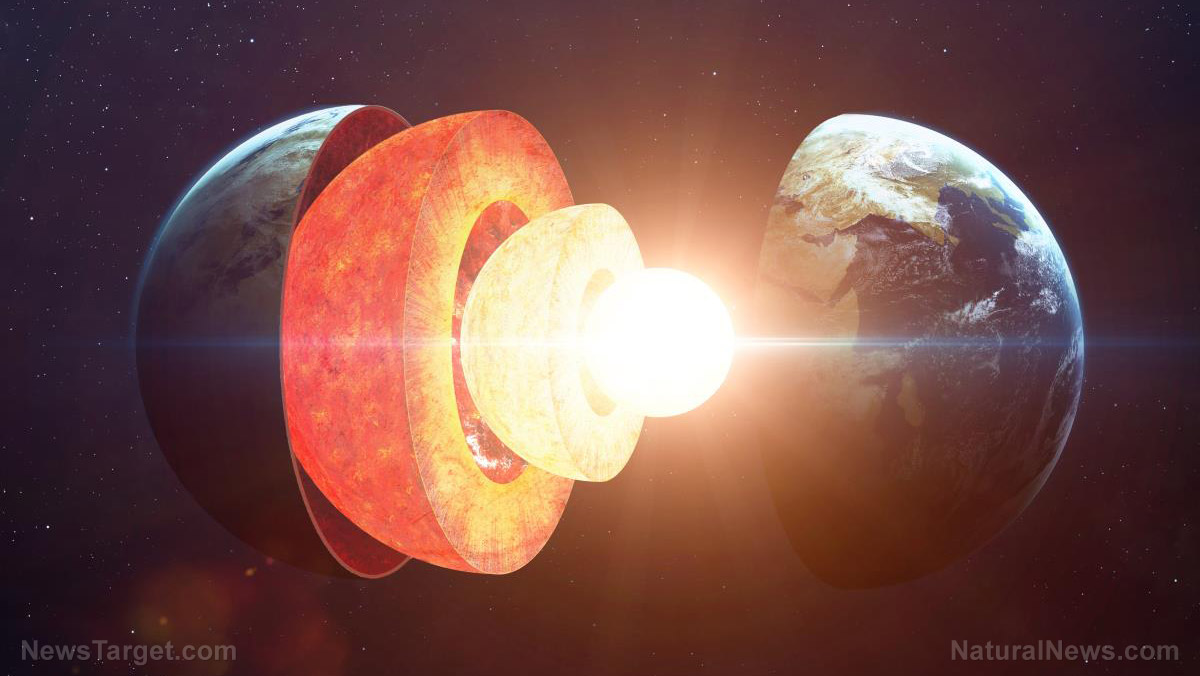Baffling new substance discovered deep inside Earth’s core
03/02/2022 / By Kevin Hughes

New study suggests that the inner core of Earth may be filled with a bizarre substance that is neither solid nor liquid.
Scientists, for more than half a century, assumed that Earth’s deepest recesses consist of a molten outer core surrounding a densely compressed ball of solid iron alloy. But new research, published last Feb. 9 in the journal Nature, provides an unusual understanding of the planet’s inner structure.
New computer simulations show that Earth’s hot and highly pressurized inner core could stay in a “superionic state” — a swirling blend of hydrogen, oxygen and carbon molecules, constantly splashing through a grid-like mesh of iron.
“We find that hydrogen, oxygen and carbon in hexagonal close-packed iron transform to a superionic state under the inner core conditions, showing high diffusion coefficients like a liquid. This suggests that the inner core can be in a superionic state rather than a normal solid state,” the researchers recorded on their paper.
Earth’s core is susceptible to bone-crushing pressures and fiery temperatures that are as hot as the Sun’s surface, and its components have been a topic of speculation among scientists and science fiction writers. Since the 1950s, breakthroughs in the study of earthquake-generated seismic waves which travel through the core have allowed researchers to make more refined speculations as to what’s inside the heart of the Earth, which until now is very unclear. (Related: Bombshell science study reveals internal heat from Earth’s hot core is what’s causing Greenland’s ice sheets to slide.)
Temperatures in the Earth’s inner core are believed to be over 5,500 degrees Celsius, which is around the same blistering heat you can expect on the surface of the Sun.
A 2021 study of how a kind of seismic wave called an S wave or shear wave moved through our planet’s interior concluded that Earth’s inner core isn’t solid iron, as was considered in the past, but is instead comprised of different states of a “mushy” material consisting of an iron alloy of iron atoms and lighter elements like oxygen or carbon.
Scientists turn to simulation using computer program
Scientists, however, weren’t sure what this mush was made up of. Entering the core by probe is impossible, so for its latest study the researchers turned to a simulation – compiling seismic data and feeding it into a state-of-the-art computer program designed to recreate the effects of the core’s intense pressures and temperatures on a variety of probable core elements like iron, hydrogen, oxygen and carbon. In a regular solid, atoms organize themselves into repeating grids, but the core simulations show that in Earth’s core, atoms would be converted into a superionic alloy – a structure of iron atoms around which the other elements, directed by powerful convection currents, are able to openly float.
“It is quite abnormal. The solidification of iron at the inner core boundary does not change the mobility of these light elements and the convection of light elements is continuous in the inner core,” study first author Yu He, a geophysicist at the Chinese Academy of Sciences, said in a statement.
If the simulation aligns itself with reality, the constant guzzling of the mushy superionic materials could help explain why the inner core’s structure seems to change so much over time and how the powerful convection currents responsible for creating Earth’s magnetic field are produced. The model, however, will have to be proven first.
“We will have to wait until the experimental setting becomes ripe to replicate the inner core conditions and scrutinize the proposed models. We will then see which of the models are physical. In the meantime, global seismology is making progress, with more seismological probes becoming rapidly available, and we hope to constrain some of the key parameters determining geophysical models of the inner core in this coming decade,” said Hrvoje Tkalcic, the head of seismology and mathematical geophysics at the Australian National University in Canberra.
More related articles:
Ice cores from top-secret Army base reveal Greenland was largely ice-free millions of years ago.
Earth’s mantle houses the remains of the ancient planet Theia, researchers suggest.
Global warming statistically insignificant: Climate emergency is imaginary.
Watch the video below to know more about strange things going on in Earth’s core.
This video is from the End Time News channel on Brighteon.com.
Follow Discoveries.news to know more about latest science discoveries.
Sources include:
Submit a correction >>
Tagged Under:
alloy, atoms, carbon, core, Earth, hydrogen, inner core, iron, oxygen, seismic waves, seismology, simulation, sun, superionic state
This article may contain statements that reflect the opinion of the author
RECENT NEWS & ARTICLES
COPYRIGHT © 2017 REAL INVESTIGATIONS NEWS



















